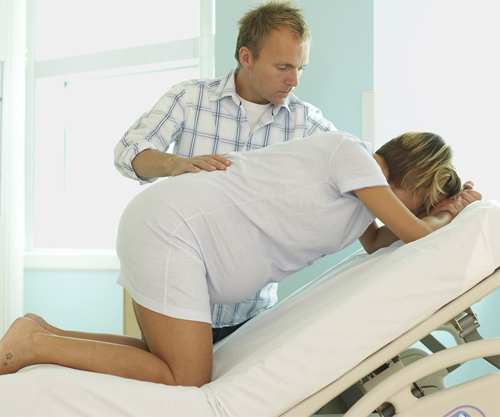The second stage begins when your cervix is fully
dilated and your baby has moved deep into the pelvis. These signs may be
accompanied by an overwhelming urge to bear down and, once your doctor
is satisfied that you are ready to do it, you will be able to push your
baby out. The third stage, the delivery of the placenta, marks the end
of labor.
NOTE
The moment of delivery is within sight and you will soon meet your long-awaited baby

Delivering your Baby
In the second stage, your labor starts to accelerate as you actively push your baby out into the world.
As you enter the
second stage of labor, you will probably experience an overwhelming
desire to bear down. Once your doctor has established that you are fully
dilated and are ready to start pushing, you may start to feel more in
control of your labor since your pushing helps move your baby farther
down into the pelvis.
The second stage
The second stage of
labor starts when your cervix is completely open, at about 10 cm, and
ends with the birth of your baby. This stage usually lasts for around 45
minutes to two hours during a first labor and from 15 to 45 minutes in
subsequent deliveries. The second stage is intense and during this time
your contractions will become stronger, but may occur less frequently,
occurring around every two to five minutes. At this point you may feel a
sensation of fullness in your vagina or bowel and have a strong urge to
push. Many women find labor pains more bearable in the second stage
since they can now actively work with the contractions and push their
baby out. Other women find this a particularly hard part of labor
because they start to feel exhausted from the effort of prolonged
pushing.
Second stage positions
Although you may be tired
and want to lie down, it’s recommended that you resist this urge in the
second stage. Your partner and nurse can give you plenty of support to
help you adopt the most comfortable position.
Staying upright
Adopting an upright
position during the second stage of labor has several advantages. The
main one is that you are using gravity to assist your baby’s descent,
which will also help you bear down and push. Being upright can also
improve the alignment of your baby in the birth canal; can increase the
efficiency of your contractions; and widens the passageway through the
pelvis.
There is also
evidence that adopting upright positions in the second stage of labor
can reduce the length of time you take to bear down and give birth, and
make it less likely that you will have an instrument delivery or
episiotomy .
Which positions to adopt
Upright positions during the second stage of labor include upright sitting and squatting positions.
If you prefer a sitting
position, try to sit in an upright or semi-recumbent position. If you
adopt a sitting position on a bed, sitting at a 45-degree angle can help
your breathing and reduce the risk of a condition known as aortocaval
compression, which can affect how well your blood is circulated around
your body and to your baby. This is caused by the weight of your uterus
and the baby pressing on major blood vessels (the aorta and vena cava),
reducing the amount of oxygen that circulates around your body, which
makes you feel light headed and dizzy. If this happens, you will be
advised to lie on your left side to relieve pressure and increase the
amount of oxygen circulating.
Because kneeling
or squatting increases the pelvic outlet, many women will naturally
adopt a squatting or all-fours position to give birth since they find
that this is the most comfortable and easy position in which to deliver
their baby. Upright squatting and kneeling positions help increase your
pelvic outlet by around 28 percent compared to when you’re in a
lying-down position. This means that there is more room for your baby to
descend through your pelvis and into the birth canal. Some women find
it hard to squat down comfortably because they are not used to being in
this position and tire easily. If this is the case, ask your partner to
support you as you squat.
Alternatively, you may
find that lying on your side is your preferred position; your partner
can help you by supporting one of your legs to keep your pelvis as open
as possible. There is also some evidence that lying on your side can
protect your perineum from tearing.
In a kneeling position, both your partner and the nurse can support you as you bear down (image).

Being on all fours with the hospital bed for support can be a comfortable position .

An upright squatting position
is good for pushing and can be adopted if you have firm support from
your partner. He can support you under the arms while you put your hands
around the back of his neck.

Using props
Some women find
using props such as a beanbag, birthing ball, pillows, or a large
cushion while kneeling and leaning forward helpful.
When to push
Your baby will start to
rotate his or her head and shoulders to enable these to descend through
your pelvis to be born, and you will feel the urge to bear down and push
as this is happening. Your doctor will help you focus and encourage you
to push when you feel the urge, which will come naturally with a
contraction. With each contraction, you will need to concentrate on
pushing down deep into the pelvic area and bottom. It can help to put
your chin on your chest and to bear down for as long as possible during a
contraction, during which time you may need to take several steady
breaths. You may feel like grunting and making noises when bearing down,
or you may prefer to breathe deeply and quietly; you should do whatever
you find helpful and works best. You will need to work with your body’s
instincts and adopt the position you find most comfortable and easy to
give birth in (see Which positions to adopt).
Pushing your baby out into the world takes a huge amount of effort and
energy, but you have the ability and are very capable of doing this.
Your doctor and birth
partner will encourage and support you throughout this stage and help
you to believe in your ability to give birth.
Your baby’s descent
The time it takes to push
your baby out once he or she is deep within the pelvis can take around
30 minutes to one hour for a first labor, although this time may be
considerably reduced in subsequent labors, sometimes taking just a few
minutes. The combined force of the contractions (which are now around
every two to five minutes) and your pushing moves your baby farther down
into the pelvic outlet. As this occurs, the pressure on your back and
rectum will intensify and you may experience a stinging sensation as
your vagina becomes fully stretched. Your doctor may tell you to stop
pushing at this point so that your perineum can thin further and so that
the baby’s head isn’t delivered too suddenly, which could cause serious
tears. She may tell you to pant or blow instead to help you resist the
urge to bear down.